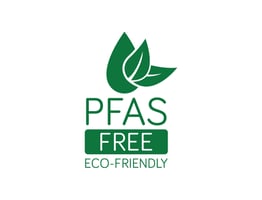In today's rapidly shifting consumer landscape, sustainability has become more than just a buzzword...
Comparing Water Repellents: PFC-Free vs. Others
See the main differences between PFC-free water repellents and other water repellents to properly understand why we are driving to PFC-free.
Understanding Water Repellents
A water repellent is an ingredient that is applied to a fabric or surface to give it water repellency. Make no mistake, this is different from water repellency. Water repellent agents are not waterproof, preventing water from passing through the material, but take advantage of water's ability to curl up by creating a film on the yarn that does not blend with water. The resulting effect is water repellency, which prevents water from seeping into the fabric. It does not prevent water from passing through, so even with high water repellency, water will pass through if pressure is applied.
There are various types of water repellents, each with its own characteristics and advantages. One of the most common is PFC-based water repellent, which has been widely used. However, it has been pointed out that they may have adverse effects on the environment and human health.
The Negative Effects of PFC-Based Water Repellents
PFC-based water repellents, also known as perfluorinated compounds, have been identified as having various potential adverse environmental and health effects. These compounds are persistent and bioaccumulative, meaning they are not easily degraded and accumulate in the environment and organisms over time.
Studies indicate that PFCs can persist in water sources and soils, posing a risk to aquatic organisms and ecosystems. They have also been detected in human blood, breast milk, and other tissues, raising concerns about their health effects.
Furthermore, the production and disposal of PFC-based water repellents can lead to pollution and depletion of natural resources. Against this backdrop, there is a growing demand for safer and more environmentally friendly alternative water repellents.
PFCs are not always 100% harmful.
It is important to note, however, that PFCs are not a definitive health hazard. Indeed, very recently, the IARC classified a substance called PFOA, which is part of PFCs, as Group 1. Some people say that this is a carcinogen, but essentially a little more explanation is needed.
For example, Group 1 includes alcohol, tobacco, ham and sausage, cadmium, dioxin, sunlight, etc. Is it true that alcohol, tobacco, and ham and sausage, for example, are banned? This is because these depend on the amount consumed. Salt is also an essential nutrient that can kill if consumed in excess.
PFOA, too, has been shown in several animal studies to have adverse effects when consumed in large amounts, but the question of how much is problematic remains unclear.
Specifically we measure PFOA by measuring it from blood levels, but it is not clear at what blood level it starts to cause problems and is still being studied in our country.
PFOA is only one of thousands of PFCs. In the end, the reality is that we still don't know much about PFCs. It is not appropriate to declare that PFCs are harmful, but it is necessary to consider whether or not to use PFCs with the understanding that they may be harmful. And in the long run, they need to be replaced by something other than these.
Introducing PFC-Free Water Repellents
PFC-free water repellents are a new generation of water repellents that do not contain perfluorinated compounds. Instead, alternative technologies and materials are used to achieve water repellency.
It is important to note, however, that PFC-free water repellents are inferior to conventional PFC repellents in terms of water repellency, or DWR performance. This is a performance degradation that inevitably occurs due to their chemical nature.
The ability to form water beads is also reduced compared to conventional PFC water repellents, and oil is not repelled. In other words, while conventional PFC water repellents have high antifouling performance, PFC-free water repellents are inferior.
The biggest problem is stability: PFC water repellents are very stable and can maintain DWR performance over the long term. However, with PFC-free repellents, the DWR performance is lost at a faster rate. This means that we now need to do more maintenance to maintain DWR performance.
Despite these disadvantages, PFC-free water repellents are increasingly being adopted by manufacturers and consumers concerned about sustainability and environmental impact. It is becoming easier to choose the product that best fits your personal values.
Advantages of PFC-Free Water Repellents
There are several advantages to choosing a PFC-free water repellent. First, they are environmentally friendly, as they are extremely unlikely to cause residues or bioaccumulation of environmentally harmful chemicals.
Second, PFC-free water repellents are safe for human health; the risk of exposure to these potentially harmful possibilities is greatly reduced by not using PFCs.
Furthermore, PFC-free water repellents provide effective waterproofing and durability in non-harsh, typical use environments. They keep fabrics and surfaces dry, preventing water damage and allowing for better performance and longer life.
However, PFC-free water repellents often still do not perform well in environments where high performance is required, such as extreme mountaineering or professional work. It may be necessary to take into account the usage conditions while making a selection.
Choosing the Right Water Repellent for Your Needs
There are several factors to consider when choosing the right water repellent for your needs. First, determine the level of DWR required. Depending on the activity and environment, a high level of water repellency may be required. In this case, we feel that choosing an PFC water repellent is a necessary option.
Next, consider the material or fabric that needs to be processed. Suitable water repellents may vary depending on the material. It is important to check compatibility and effectiveness.
In addition, consider environmental and health considerations. If sustainability is a priority, it would be wise to choose a PFC-free water repellent.
Finally, consider application method and convenience. Some water repellents require professional application, while others can be easily applied by individuals.
The best advantage of personal application is that it is easy. Professional application is more tedious, but may provide a level of high DWR performance that cannot be achieved by an individual, so consider professional application if that performance is important to you.


